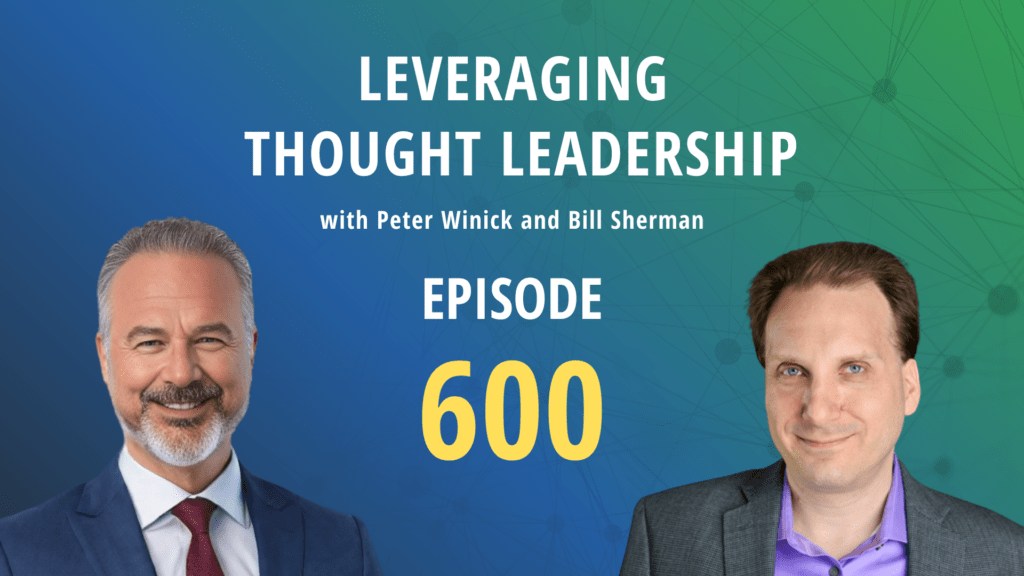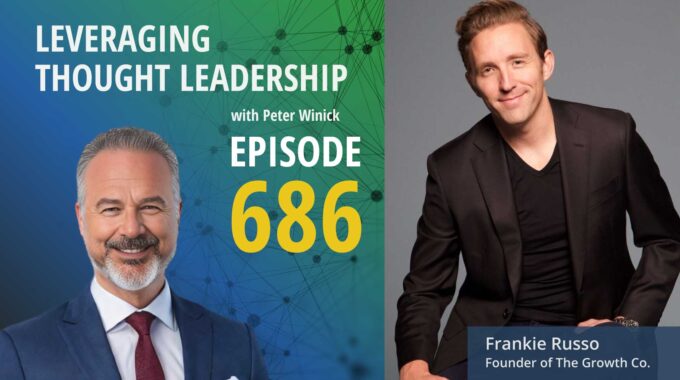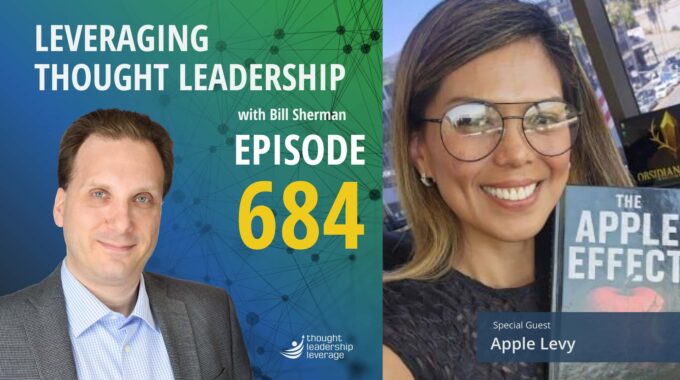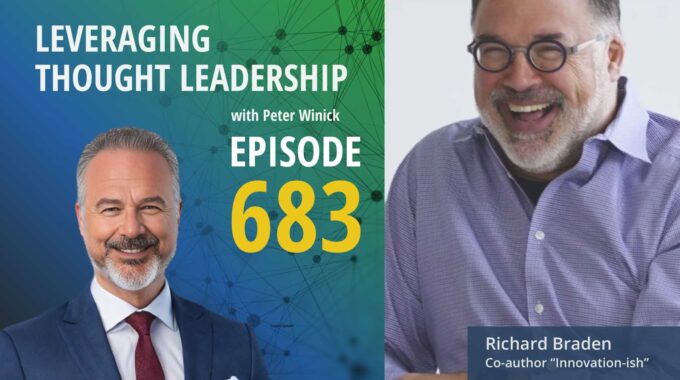How “collective genius” drives continuous growth. This episode shows how to scale thought leadership beyond…
The Real Profit Behind Business Books: Key Findings from 350+ Authors

How Thought Leaders Turn Books into Revenue Powerhouses with Speaking and Consulting
Peter Winick and Bill Sherman sit down to discuss some of the intriguing findings from the Book ROI study they’ve been involved in for the last several months.
What’s the ROI of a business book?
Peter Winick and Bill Sherman dive into this game-changing question in the latest episode of Leveraging Thought Leadership. Partnering with industry giants like Gotham Ghostwriters, Amplify Publishing Group, and Smith Publicity, they’ve launched the most comprehensive study on the ROI of business books to date. Over 350 authors participated, and the results are eye-opening.
The data shows 64% of business books turn a profit, with a median of $11,350 for books that have been out for at least six months. But here’s where it gets interesting—authors with a clear strategy saw a median profit of $96,000. The key takeaway? Profit is more about strategy than sales alone. Books with a robust launch plan, PR efforts, or even ghostwriting support outperform those without. For every dollar spent, the average book generates $1.24 in revenue—not just from book sales but from lucrative add-ons like speaking engagements, consulting, and workshops.
Another intriguing finding? Authors with weak strategies ended up spending more than those with a focused approach. And when it comes to satisfaction with publishers, hybrid models shine. 70% of authors using traditional or hybrid publishing were satisfied, but hybrid authors were twice as likely to be enthusiastic about their experience.
Catch the full episode and dive into the data at authorroi.com.
Three Key Takeaways
Strategic planning drives profits: Authors with a clear strategy around their book—like PR, launch plans, and ghostwriting—saw a median profit of $96,000, significantly higher than those without a plan.
Revenue extends beyond book sales: For every $1 spent on a business book, authors generated $1.24 in revenue, with most of the profit coming from related services like speaking, consulting, and workshops, not just book sales.
Hybrid publishing leads to higher satisfaction: Hybrid authors were twice as likely to express strong satisfaction with their publishing experience compared to traditional or self-published authors.
Transcript
Peter Winick And welcome, welcome, welcome. This is Peter Winick. I’m the founder and CEO at Thought Leadership Leverage. And you’re joining us on the podcast today, which is Leveraging Thought Leadership. And this is a special edition for a couple of reasons. Number one, we hit around numbers, so that’s worth celebration. This is the 600th episode that we are putting out into the universe. And then reason number two, this is fun is Bill Sherman, my co-host, is actually the guest today or the co guest or the co-host, co guest, whatever. And we are going to talk about the release of the single most comprehensive research study on the ROI of a business book that we are a sponsor of, along with some of our partners that we’ll get to in a little bit. So anyway, first off, welcome, Bill.
Bill Sherman Joy to be here. And it’s a joy to be talking about this research study.
Peter Winick Yeah. So this has been going on for several months. So I’ll start with sort of the origin story and then handed to you to talk about what we did and what we learned and where we’re going with it. Anyone interested in downloading the survey, it is available for free. It is the business book ROI research study and you can download it at authorroi.com. So you can just go to that site and download it and you’ll be good to go. So let me give you the quick back story here. A couple of months ago, my friend Dan Gerstein, who is the founder and CEO of Gotham Ghostwriters, called me up and he said, hey, I had a client ask me this question and I’ve been trying to find the answer to it, and I haven’t had any luck. I thought you might be able to give me some insight on it. And I said, sure. So what the client asked him was, Wow, okay. It’s a significant investment between the ghostwriter and publishing an opportunity cost, etc., to write a nonfiction business book. Has anybody done any research on the ROI of that? So Dan snooped around, found nothing. I said, That is a really good question. Let me see if I can help. I spent a day or two snooping around, making some calls and I couldn’t find anything. So I called Dan back and I said, We have some good news and some bad news. The bad news is I can’t help you. I can’t answer that question. The good news is I think we identified an opportunity, and we should go forward and figure this out. So we reached out to a couple of folks that are good friends. Naran at Amplified Publishing, Dan at Gotham Ghostwriters, Smith Publicity. And then we engaged Josh Bernoff to help us write this. So those are your sponsors of the survey. And to add to that, it takes a village. Bill, we’ll get to this in a little bit. We talked to a lot of people. We talked to hundreds and hundreds of authors. And even though we have a pretty slick network, we needed to reach out to our network of friends to help us do that. So we’ve reached out to probably a dozen other supporting sponsors, if you will. Everyone from, let’s see, the Greenleaf Book Group. Jane Westman, Page two Publishing, Marshall Goldsmith, 100 coaches, and probably about a dozen others. I didn’t mean to leave anybody out, but I want to get to the podcast instead of just thinking it through. All right. This took a village to get through. So anyway, let me let me end to back to you, Bill, and give us the A. What was the methodology that we used here? And then, B, what were the maybe the top three things that we were.
Bill Sherman Yes. So let’s dive in with a couple of things. As you said, this wound up being the largest nonfiction book study that we know of. I mean, in terms of understanding authors, revenue expenses, experience. And that data wasn’t collected anywhere. Right. And so, as you said, it was an opportunity. More data driven thought leadership, the ability to answer questions that an audience that we deeply care about. Was asking. Right. Or would be deeply interested in. And so to reach this audience, we had to ask people who had written and published books. And you can’t simply go to a group like SurveyMonkey and say, Hey, will pay a bunch of money. Can you pull some people for us and collect some data? No. It takes a village, as you said, to find people. We had over 350 authors respond. 301 had published a nonfiction book and two thirds had published multiple books. And so that was a fantastic response from the nonfiction and business book author community. And so I want to give a shout out to everyone who. She heard the Paul leaned in and sat down and took the survey, which wasn’t a quick three minute, you know, Likert scale 1 to 5 and you’re done. We asked some deep questions and in order to get meaningful data. We went deep. And the participants, those who completed the survey, spent over 20 to 30 minutes on the survey providing meaningful information. So there’s a layer of gratitude not only for the sponsors and the people who help amplify and reach out to their communities of authors. And then finally, the authors who said, yes, this is worth my time.
Peter Winick Great. The investment that everybody made in time and energy is duly noted and greatly appreciated. Okay. So that being said, let’s talk about what the top 3 or 4 takeaways were from the report and everybody out there listening. Again, you can go to author ROI Seacom and download the full report to read for yourself.
Bill Sherman So let’s go into a couple of the top line pieces. Number one, good news. 64% of business books showed a gross profit. And the median profit for a book that had been out for at least six months was $11,350. But let’s go a little bit further. Authors who invested in the book to make it more successful through things like a strategy, launch, PR and ghostwriting. All of those activities were correlated with increased profitability and so on. The revenue to strategy correlation books with a strong revenue strategy had a median gross profit of $96,000. So the question becomes, if you know what you’re trying to accomplish with your book, you have a much better chance of accomplishing it with a clear strategy. And if your goal is financial, you need a clear strategy to be able to elevate those returns.
Peter Winick So it was great to hear this return number that people got that invested in the strategy. Selfishly speaking for you and I. Bill Right. Like given that that’s how we spend most of our days developing strategies for people that are writing books or are thinking about writing books, that was really important to hear. I think it’s also equally important to realize that the magic formula, there is no magic formula here, but if it was, is not something as simple as number of units sold time, some gross profit margin per unit, that varies whether you go hybrid or sell for traditional. So would the money come from bill it? So let’s go back to that $96,000 question.
Bill Sherman Yes. So if we look at revenue books generate $1.24 in revenue for each dollar spent. But the majority of that revenue isn’t coming from book sales. It’s coming from supporting services. So that can be keynotes, speeches, it can be consulting, it can be workshops and those types of offerings that fit within a thought leadership ecosystem wound up generating far more revenue for the authors than direct book sales.
Peter Winick Yeah. So if you’re just going to publish a book and expect the ROI to be book sales, be cautious. What else do we learn here? I mean, we learned a lot, But just in terms of giving folks a highlight here.
Bill Sherman Well, it’s probably no surprise that writing and this is a quote that I loved from one of the respondents. Writing can be a lonely and frustrating process. And so if you’re going on that journey and you’re writing that book, having the strategy to go forward makes it easier to get the return. And the thing I want to call out on that is it also helps you boost ROI because you know where you’re spending and investing time and money. So what was interesting was around the relationship between strategy and unexpected book costs. 69% of authors with a self-reported weak strategy had additional costs, unexpected costs. Whether that was a little more or a lot more. So, again, that indicates that book strategy really binds to how you manage the production and the go to market to drive revenue for yourself and create impact in the world.
Peter Winick Yeah. I love that. Well, and that spending issue is, you know, there are many, many industries designed to help authors, you know, air quotes, get their books out there, you know, be number one on a list. On and on and on and on. And many of them had, you know, at face value or at first blush, appear to be logical, appear to be rational, appear to be valuable. So, in essence, you know, we’re seeing a lot of smart people making investments in things. The first time when they write a book that they wouldn’t repeat the second time, or in the absence of a strategy, trying, you know, throwing a bunch of stuff against the wall. Both are expensive. Right. So throwing stuff against the wall is really, really expensive. So that’s a that’s a good takeaway.
Bill Sherman It absolutely is. And there are places where you can spend money wisely. As we saw in the study. While we can’t determine causation. We can identify a correlation and say people who do these things see a higher return and report a higher return than authors that didn’t. So authors who had. A financial goal and a clear strategy. Earned $100,000 in revenue, which was twice as much as those who lacked a clear strategy but had a financial goal.
Peter Winick And yeah, that’s significant. If you’re enjoying this episode of Leveraging Thought Leadership, please make sure to subscribe. If you’d like to help spread the word about our podcast, please leave a five-star review at ratethispodcast.com. Forward slash l t l and share it with your friends. We’re available on Apple Podcasts and on all major listening apps as well as at ThoughtLeadershipLeverage.com/podcast. When it comes to goals, one of the things that I found interesting is authors had lots of goals that they identified that they put out there, right? Some would be ones that you might guess they would want and others not. What give us a sense of what some of those goals were.
Bill Sherman Bill Yeah. So in terms of goals, we tested over ten different possible goals and ask people, what’s this goal of yours? What’s your primary goal? And then did you accomplish it? Right. And again, this ties to strategy. Couple of the top goals, sharing knowledge at 78%, elevating the topic within an audience 68% and boosting the authors reputation 67%.
Peter Winick So if because those three, you know, are really somewhere between intrinsic intellectual brand ego, right? Those don’t necessarily come with a hard dollar sign. But if I had a goal to elevate the topic, meaning it’s going to be discussed by these type of people in these formats more often, I could gauge that, right? I want to bring my thought leadership to the next level or to Davos or to my industry or to my place. You could monitor. Did that happen? Right. Even though that exemplary abstract goal. But you could actually come pretty close to measuring it. So they identified those three goals or we’re talking about those three out of ten. You could see the rest of them in the report. How did people feel about, you know, after the fact? Well, I accomplished that. This was the goal I set out to achieve. Did I hit the mark or not?
Bill Sherman So in the report, you’ll see that people reported different primary goals and it’s the process of writing a book. The median was ten months, right? So it’s a personal journey. That’s a time investment that requires the support of family, friends, sacrifice of weekends. But what I found interesting there was that regardless of goal for each goal, less than 67% of authors reported that they had a solid plan or what they wanted to accomplish on their goals.
Peter Winick Yeah, so there’s that. There’s both that I’ll botch, which is, you know, a goal without a plan is, is a dream, right?
Bill Sherman Exactly. Exactly. Yeah. And so that ability to know what am I trying to achieve. Through my goals in writing this book and how am I going to measure it? And where am I going to spend time, money, effort after the manuscript is done and off to the printer? Okay. Is as important as Can I start on page want.
Peter Winick Like maybe more, but maybe even more important.
Bill Sherman Yeah, exactly. Because the book is a 5-to-7-year asset. Yes. And it’s not going to go out into the world and revolutionize things on its own.
Peter Winick Yep. So the last thing I want to hit on a little bit, given this is a business book research study. Books need to be published. How do we go about doing that? Right. So people ask me all the time and I’m sure you get asked this frequently as well, Bill. Well, what’s the best plan? You know, what’s the best way to publish? And number one, I think that’s a bad question. I think what you need to think about is what is the best way for me to publish given my goals, budgets, timelines, etc., etc.. That’s really a better question. There are three primary ways that one can publish. There’s self-publishing, there’s hybrid publishing, and there’s traditional. So what did the data tell us about those things, Bill? Anything noteworthy there?
Bill Sherman Yes. So we asked the question of how was your most recent book published? And among those 300 authors, we had a pretty good balance of respondents. 35% of authors had published traditional Yeah, 1% had published on a hybrid format and 28% were self-published. So it was a really good representation. What we saw was 70% of traditional and hybrid authors were satisfied. But there was an interesting insight. We dug a little bit deeper into the data. Hybrid published authors were twice as likely to have voiced strong agreement about satisfaction with their publisher.
Peter Winick Yeah, So that’s that is a fascinating insight that we gleaned because if you look at it sort of the inverse of that after the fact, people that have self-published were frustrated, disappointed, etc.. I think on the traditional publishing side, people are somewhere between enamored, flattered, elated early on to get that publishing deal. But then you ask them after the fact, Hey, what was that experience like working with Big Publisher X? Right. But it was really interesting that Hybrid came up on top there in terms of, I guess what I would call author satisfaction score, for lack of a better term. And that’s really interesting. And it could be because you have alignment around business objectives. It could be because your client, right, when you’re with a big publisher, you kind of work for them. You know, when you’re engaging with a hybrid publisher, you’re writing the checks, right? So you’re the boss and you need to be treated as such. So that was an interesting insight, not necessarily one that we might have expected to come to light here.
Bill Sherman So I want to close with a couple of quotes from you that I think would be relevant here.
Peter Winick These are the quotes from people that actually took the survey.
Bill Sherman Exactly. Exactly. So this author was hybrid published and was talking about their first book. Authors don’t make money on book sales. They make money on what the book makes possible. Spend time and money getting the book off the shelf. Yeah. Additionally, another author said, I can divide my career into two parts before book and after book. And so when I conducted interviews along with this study, one of the things that I heard again and again was the authors who use the book as a tool, who were out there promoting, speaking passionately about the idea in an authentic way that you really can’t manufacture a fake. But they had written the book because they cared about the ideas. They wanted to evangelize them. They found their audience and they found their market. As a result.
Peter Winick Yeah. And I like that way of thinking about it pre and post. Well, this, this has been fun. So again, 600 episodes. Holy cow. That’s. That’s a lot like we started this seven years ago. Really, really interesting findings and we just skimmed the sort of the top line here again go to author arrow icon and would love to hear everybody out. There’s feedback and thoughts on what they think about the report as well. Well, thanks for your time. This has been great and I will definitely talk to you again shortly. Thanks, Bill.
Bill Sherman Thanks, Peter.
Peter Winick To learn more about Thought Leadership Leverage, please visit our website at ThoughtLeadershipLeverage.com. To reach me directly. Feel free to email me at Peter at ThoughtLeadershipLeverage.com. And please subscribe to Leveraging Thought Leadership on iTunes or your favorite podcast app to get your weekly episode automatically.





